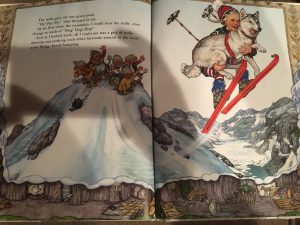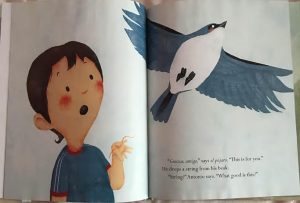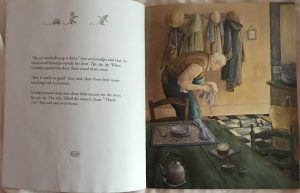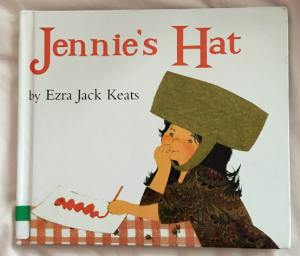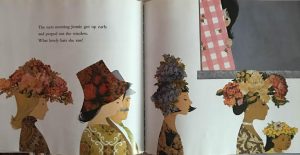![IMG_9616 [405973]](https://blogs.iwu.edu/lrbmt2016/files/2016/05/IMG_9616-405973-234x300.jpg)
Author/Illustrator: David McKee
Publisher and Year: McGraw-Hill, 1968
Number of Pages: 30
Genre: Fable/Fiction
![IMG_9617 [405974]](https://blogs.iwu.edu/lrbmt2016/files/2016/05/IMG_9617-405974-220x300.jpg)
Analysis: Elmer the elephant is beautifully different, but he doesn’t see it that way. He goes through some extreme measures to be “normal” until he realizes that it’s good to be different. This book can work as a mirror for children who feel that they are different in some way. Often times in society, being outside of the “norm” is frowned upon, and it shouldn’t be. People should feel comfortable with their differences because those are what make them unique. The jungle life is prevalent in this book, and even the non-elephants accept Elmer for who he is. Rarely did the animals express a face of disgust for Elmer’s appearance. As long as he plays his part in society, he is okay in their eyes.
Perceptually, this book has very plain text, and it clearly explains pictures and stays off to the side.
Structurally, Elmer walks to the right until he is like the rest of the elephants, which is when he feels normal. All of the animals appear to be the same size as Elmer, even though elephants are clearly bigger than pigs. There appears to be many bright colors at the end when Elmer feels free.
“Elmer” teaches that people should accept who they are because it is not the outside that matters.

![IMG_9618 [405975]](https://blogs.iwu.edu/lrbmt2016/files/2016/05/IMG_9618-405975-217x300.jpg)
![IMG_9619 [405976]](https://blogs.iwu.edu/lrbmt2016/files/2016/05/IMG_9619-405976-178x300.jpg) Analysis: “The Red Tree” is about a young girl who feels trapped in a world of—what seems to be—never-ending sadness. It is not until she realizes that she has to take the good with the bad that her “red tree” grows. This book works well as a mirror for a lot of young girls who feel that they are trapped in a bubble of sadness or sorrow. In the beginning, the young girl feels helpless and almost like she has no power over her life. By the end of the book, she is rejuvenated and hopeful. The images of darkness and confusion seem to be an accurate representation of what sadness would look like if it was tangible.
Analysis: “The Red Tree” is about a young girl who feels trapped in a world of—what seems to be—never-ending sadness. It is not until she realizes that she has to take the good with the bad that her “red tree” grows. This book works well as a mirror for a lot of young girls who feel that they are trapped in a bubble of sadness or sorrow. In the beginning, the young girl feels helpless and almost like she has no power over her life. By the end of the book, she is rejuvenated and hopeful. The images of darkness and confusion seem to be an accurate representation of what sadness would look like if it was tangible.![IMG_9622 [405979]](https://blogs.iwu.edu/lrbmt2016/files/2016/05/IMG_9622-405979-222x300.jpg) Author/Illustrator: Oliver Jeffers
Author/Illustrator: Oliver Jeffers![IMG_9623 [405980]](https://blogs.iwu.edu/lrbmt2016/files/2016/05/IMG_9623-405980-169x300.jpg)
![IMG_9611 [405969]](https://blogs.iwu.edu/lrbmt2016/files/2016/05/IMG_9611-405969-300x210.jpg) Authors: Phillip and Hannah Hoose
Authors: Phillip and Hannah Hoose![IMG_9613 [405970]](https://blogs.iwu.edu/lrbmt2016/files/2016/05/IMG_9613-405970-300x148.jpg) Analysis:“Hey, Little Ant” is a story about a child that contemplates whether or not he should spare an ant’s life. After putting himself in the ant’s shoes, the boy sees that maybe he shouldn’t squish the bug after all. This text could primarily work as a window. It is common in America to carelessly step on small bugs, such as ants. This book could give us a glimpse of the bug’s perspective. This book also allows children to step out of the egocentric world that they live in, where everything is “I view it this way, so that’s how it must be.” In the story, the power somewhat shifts from the big and mighty kid to the ant, who ultimately could’ve convinced the boy not to step on him. When the ant tells the kid to imagine that he was the ant and the ant the kid, the boy starts to feel for the ant.
Analysis:“Hey, Little Ant” is a story about a child that contemplates whether or not he should spare an ant’s life. After putting himself in the ant’s shoes, the boy sees that maybe he shouldn’t squish the bug after all. This text could primarily work as a window. It is common in America to carelessly step on small bugs, such as ants. This book could give us a glimpse of the bug’s perspective. This book also allows children to step out of the egocentric world that they live in, where everything is “I view it this way, so that’s how it must be.” In the story, the power somewhat shifts from the big and mighty kid to the ant, who ultimately could’ve convinced the boy not to step on him. When the ant tells the kid to imagine that he was the ant and the ant the kid, the boy starts to feel for the ant.
